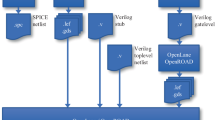Abstract
We applied the stochastic salp swarm algorithm (SSA) to design high power amplifier (PA) and digital pre-distorter (DPD) using generalized memory polynomial model. This algorithm has high exploitation and convergence speed to solve the non-linear coefficient of memory polynomial. We considered a single carrier WCDMA input for the static non-linearity of the memory based high power amplifier. Various simulations have been conducted to validate the performance of SSA over PA and DPD using different memory depths and degrees combinations which demonstrates that the proposed approach is an effective solution for linearity of high generation wideband transmitters. The performance of SSA is compared with particle swarm optimization and shows the superiority of SSA in terms of lower adjacent channel power ratio, error vector magnitude, normalized mean square error and modeling error. The implementation of SSA on PA and DPD has been done separately and then cascaded to generate a resultant linear output.









Similar content being viewed by others
References
Cripps, S. C. (2006). RF power amplifiers for wireless communications (Artech House Microwave Library (Hardcover)). Norwood, MA: Artech House Inc.
Ghannouchi, F. M., & Hammi, O. (2009). Behavioral modeling and predistortion. IEEE Microwave Magazine, 10(7), 52–64.
Zhang, D., Xu, X., Yu, H., Li, J., Kumar, T. B., Ma, K., et al. (2017). Predistortion linearizer for wideband AM/PM cancelation with left-handed delay line. IEEE Microwave and Wireless Components Letters, 27(9), 794–796.
Belabad, A. R., Motamedi, S. A., & Sharifian, S. (2017). An adaptive digital predistortion for compensating nonlinear distortions in RF power amplifier with memory effects. Integration, the VLSI Journal, 57, 184–191.
Hammi, O., Carichner, S., Vassilakis, B., & Ghannouchi, F. M. (2008). Synergetic crest factor reduction and baseband digital predistortion for adaptive 3G Doherty power amplifier linearizer design. IEEE Transactions on Microwave Theory and Techniques, 56(11), 2602–2608.
Safari, N., Roste, T., Fedorenko, P., & Kenney, J. S. (2008). An approximation of Volterra series using delay envelopes, applied to digital predistortion of RF power amplifiers with memory effects. IEEE Microwave and Wireless Components Letters, 18(2), 115–117.
Sappal, A. S., Patterh, M. S., & Sharma, S. (2010). A novel black box based behavioral model of power amplifier for WCDMA applications. Communications and Network, 2(03), 162–165.
Yu, C., Lu, Q., Sun, H., Wu, X., & Zhu, X. W. (2018). Digital Predistortion of ultra-broadband mmWave power amplifiers with limited Tx/feedback loop/baseband bandwidth. Wireless Communication and Mobile Computing, 2018, 1–11.
Sappal, A. S., Patterh, M. S., & Sharma, S. (2011). Fast complex memory polynomial-based adaptive digital predistorter. International Journal of Electronics, 98(7), 923–931.
Morgan, D. R., Ma, Z., Kim, J., Zierdt, M. G., & Pastalan, J. (2006). A generalized memory polynomial model for digital predistortion of RF power amplifiers. IEEE Transactions on Signal Processing, 54(10), 3852–3860.
Smirnov, A. V. (2018, July). Optimization of digital predistortion with memory. In Proceedings of conference on systems of signal synchronization, generating and processing in telecommunications (SYNCHRO INFO) (pp. 1–6). Minsk: IEEE.
Yang, X. S. (2010). Nature-inspired metaheuristic algorithms. Bristol: Luniver Press.
Belabad, A. R., Sharifian, S., & Motamedi, S. A. (2018). An accurate digital baseband predistorter design for linearization of RF power amplifiers by a genetic algorithm based Hammerstein structure. Analog Integrated Circuits and Signal Processing, 95(2), 231–247.
Chen, S. (2011). An efficient predistorter design for compensating nonlinear memory high power amplifiers. IEEE Transactions on Broadcasting, 57(4), 856–865.
Manjula, S., & Selvathi, D. (2015). Optimal design of low power CMOS power amplifier using particle swarm optimization technique. Wireless Personal Communication, 82(4), 2275–2289.
Abdelhafiz, A. H., Hammi, O., Zerguine, A., Al-Awami, A. T., & Ghannouchi, F. M. (2013). A PSO based memory polynomial predistorter with embedded dimension estimation. IEEE Transactions on Broadcasting, 59(4), 665–673.
Wang, S., Hussein, M. A., Venard, O., & Baudoin, G. (2018). A novel algorithm for determining the structure of digital predistortion models. IEEE Transactions on Vehicular Technology, 67(8), 7326–7340.
Bipin, P. R., & Rao, P. V. (2016). Linearization of high power amplifier using modified artificial bee colony and particle swarm optimization algorithm. Procedia Technology, 25, 28–35.
Bipin, P. R., Rao, P. V., & Issac, A. (2016, February). A novel predistorter based on MPSO for power amplifier linearization. In Proceedings of international conference on emerging trends in engineering, technology and science (ICETETS) (pp. 1–6). Pudukkottai: IEEE.
Kim, J., & Konstantinou, K. (2001). Digital predistortion of wideband signals based on power amplifier model with memory. Electronics Letters, 37(23), 1417–1418.
Landin, P., Isaksson, M., & Handel, P. (2008, June). Comparison of evaluation criteria for power amplifier behavioral modeling. In Proceedings of IEEE MTT-S international microwave symposium digest (pp. 1441–1444). Atlanta: IEEE.
Kuo, H., Cheung, S. W., & Hau, S. S. (2006, May). A novel peak-windowing technique for WCDMA systems. In Proceedings of IEEE 63rd vehicular technology conference (Vol. 4, pp. 1758–1761). Melbourne: IEEE.
Shi, Y. (2001). Particle swarm optimization: developments, applications and resources. In Proceedings of the 2001 congress on evolutionary computation (IEEE Cat. No. 01TH8546) (Vol. 1, pp. 81–86). Seoul: IEEE.
Mirjalili, S., Gandomi, A. H., Mirjalili, S. Z., Saremi, S., Faris, H., & Mirjalili, S. M. (2017). Salp Swarm Algorithm: A bio-inspired optimizer for engineering design problems. Advances in Engineering Software, 114, 163–191.
Acknowledgements
We thank the anonymous reviewers and the Editor for their valuable comments which helped us to improve the quality and presentation of the paper.
Author information
Authors and Affiliations
Corresponding author
Ethics declarations
Conflict of interest
On behalf of all authors, the corresponding author states that there is no conflict of interest.
Additional information
Publisher’s Note
Springer Nature remains neutral with regard to jurisdictional claims in published maps and institutional affiliations.
Rights and permissions
About this article
Cite this article
Malhotra, M., Sappal, A.S. SSA optimized digital pre-distorter for compensating non-linear distortion in high power amplifier. Telecommun Syst 72, 179–188 (2019). https://doi.org/10.1007/s11235-019-00565-9
Published:
Issue Date:
DOI: https://doi.org/10.1007/s11235-019-00565-9




